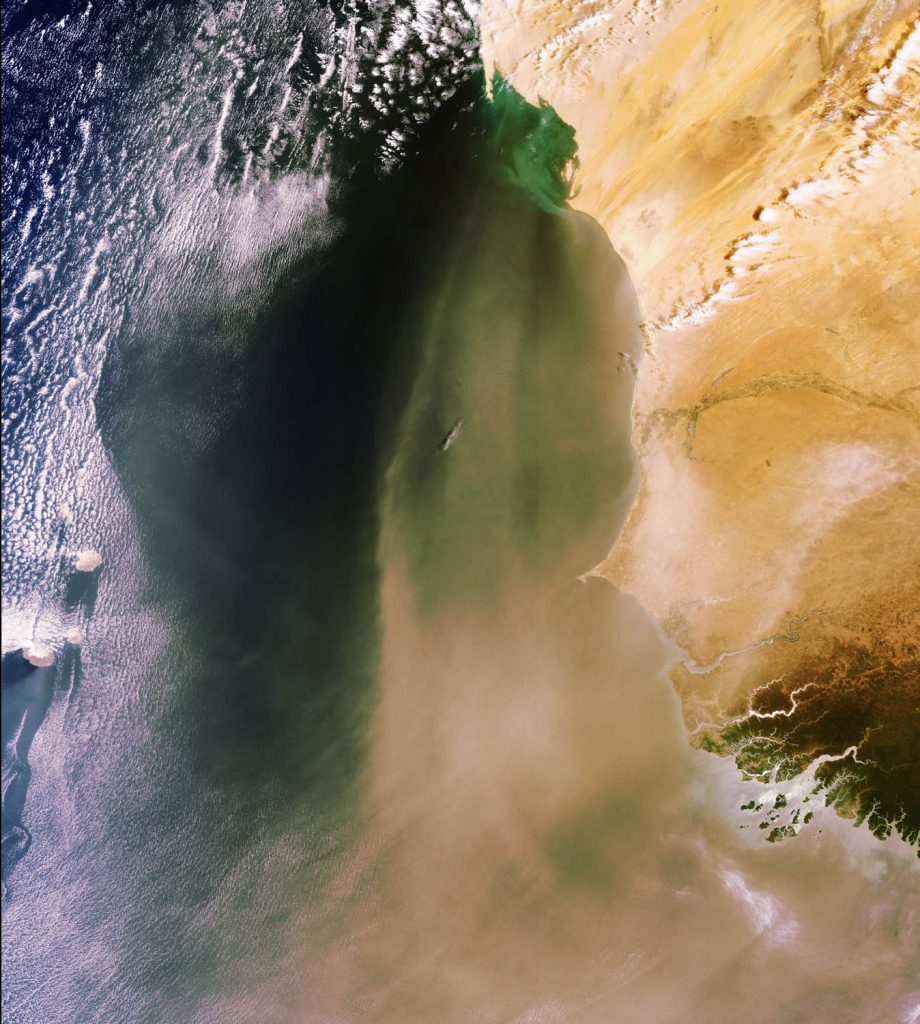Ragged Point, on the east coast of Barbados, is best known for its 19th century lighthouse, steep cliffs, and opportunities to hike and fish. But it’s also become the hub of ground-breaking scientific research that can make a meaningful impact on public health and how we approach climate change.
In 1966, researchers from the University of Miami established the Barbados Atmospheric Chemistry Observatory (BACO) at Ragged Point. Set up to study Sahara dust, it was the first of its kind and the reason we know as much as we do today about the phenomenon.
As many in the region know, every year — peaking between June and August — large plumes of dust and other particles from the Sahel region in Africa travel 5,000 miles by wind to the Americas.
Everything in the atmosphere — dust and other particles, clouds, gases, radiation from the sun — impact each other. Together, they in turn impact the atmosphere, weather, and climate, so that they’re best studied together. As a result, other significant meteorological facilities were set up at or near Ragged Point by research and education organisations around the world.
In 1978, the University of Bristol, Massachusetts Institute of Technology (MIT), and other organisations established the Advanced Global Atmospheric Gases Experiment (AGAGE) as part of a network of global facilities to monitor harmful greenhouse gases.
Then in 2010, the Hamburg-based Max Planck Institute for Meteorology founded the Barbados Cloud Observatory.
And last September, the United States Naval Research Laboratory (NRL) announced the completion of the first phase of the BACO-based Moisture & Aerosol Gradients/Physics of Inversion Evolution (MAGPIE) programme, the aim of which is “to study the exchange processes of heat, moisture, African dust, and sea spray between the atmosphere and ocean over the Subtropical Atlantic Ocean.” The programme will use research aircraft, satellite remote sensing courtesy NASA, and lidar/laser and radar technology.
US-based researchers have found that serious Sahara dust outbreaks in the Caribbean have increased by 10% since 1981 — and that the dust is contributing to drought in the Caribbean
BACO’s compound already had a sun photometer, which gives aerosol optical depth (AOD) — a measurement of how much dust there is in the atmosphere. The photometer is part of NASA’s Aerosol Robotic Network (Aeronet), which measures AOD around the world.
All of this has made Barbados a key location for atmospheric science.
“Barbados and Ragged Point provide a unique source of information on the intercontinental transport of materials from Africa,” explains Professor Joseph Prospero of the University of Miami, the research pioneer who founded BACO.
“Africa emits between 50% and 70% of the total dust emissions to the global atmosphere. Much of this is carried westward across the Atlantic, where it impacts the Caribbean Basin and the bordering land masses — the southern United States, Central America, and northern South America. Barbados happens to lie directly in the major summer transport path.”
Barbados is also the site of the Caribbean Institute of Meteorology & Hydrology (CIMH) — an arm of CARICOM, and the main body for meteorological education and research in the region. Established in 1967, the CIMH worked with the Max Planck Institute to establish the Cloud Observatory, which is co-managed by the two institutions.
Dr Andrea Sealy — a meteorologist and lecturer at the CIMH who studied at Howard University and other institutions in the United States before returning to Barbados in 2008 — is the foremost expert on Sahara dust in the English-speaking Caribbean.
“Just before I returned to Barbados, I worked at the National Centre for Atmospheric Research and worked on some climate and dust modelling,” she says. “That piqued my interest in studying Sahara dust, [as did] the fact that Barbados is home to the longest running dust record … In the Caribbean, there was a void in terms of Sahara dust and air quality work in general, [so] I decided to run with it, and have not regretted it.”
The Sahara dust plumes bring to the Americas important nutrients for the soil and ocean, but it’s an annoyance and even a danger for people with respiratory ailments or sensitives. It may be causing asthma, and some research has found it increases cases of chronic obstructive pulmonary disease (COPD). It reduces visibility on the roads and in the sky, and can cause the air quality in the Caribbean to be as bad as major industrialised cities. And things may be getting worse.
“Generally, what we have been seeing in recent years is that we’ve been getting more intense dust episodes earlier in the year and going into the summer,” said Dr Sealy during an online presentation in April that was part of Columbia University’s Caribbean Climate & Health Responders course.
In June 2020, what was called the “Godzilla dust event” roiled the Caribbean and parts of the US for more than a week. It was the biggest such occurrence in decades. The air quality index in Trinidad & Tobago registered close to the highest value of 500, within the range that’s deemed hazardous.
Among new equipment is an instrument that will measure trace metals in the atmosphere, which could help researchers figure out why cases of paediatric asthma are so high in Barbados and other parts of the eastern Caribbean
US-based researchers have found that serious Sahara dust outbreaks in the Caribbean have increased by 10% since 1981 — and that the dust is contributing to drought in the Caribbean.
Scientists aren’t sure what caused the “Godzilla event”.
“It is possible we will have more intense dust episodes occurring,” Dr Sealy told Caribbean Beat. “However, because of the uncertainty in climate prediction for the source regions in North Africa, there is still debate on how ‘dusty’ the future climate will be.
“So even though increased anthropogenic activity should cause more desertification and more dust lifted into the atmosphere to be transported,” she explained, “there is still uncertainty. For example, NASA published a study where they predict at least a 30% reduction in Saharan dust activity from current levels over the next 20–50 years, and a continued decline beyond that.”
Dr Sealy and other researchers are working to improve forecasting systems to warn people days in advance of impending dust events and about their severity. This is part of her work as chair of the Pan-American node for the World Meteorological Organisation’s Sand & Dust Storms Warning Advisory & Assessment System (SDS-WAS) — set up in 2007 to boost early warning efforts.
CIMH aims to be the forecasting centre for the Pan-American region, and the BACO site was recently upgraded with a new tower — from which will be hung the all-important filters that have been used for almost six decades to capture the dust that will be studied.
Among new equipment is an instrument that will measure trace metals in the atmosphere, which could help researchers figure out why cases of paediatric asthma are so high in Barbados and other parts of the eastern Caribbean.
In reflecting how far the Ragged Point facility has come, Professor Prospero said: “It has been a long struggle to persuade people of the importance of this work. But it is now recognised as a critical component in understanding the direction and impact of climate change.”

